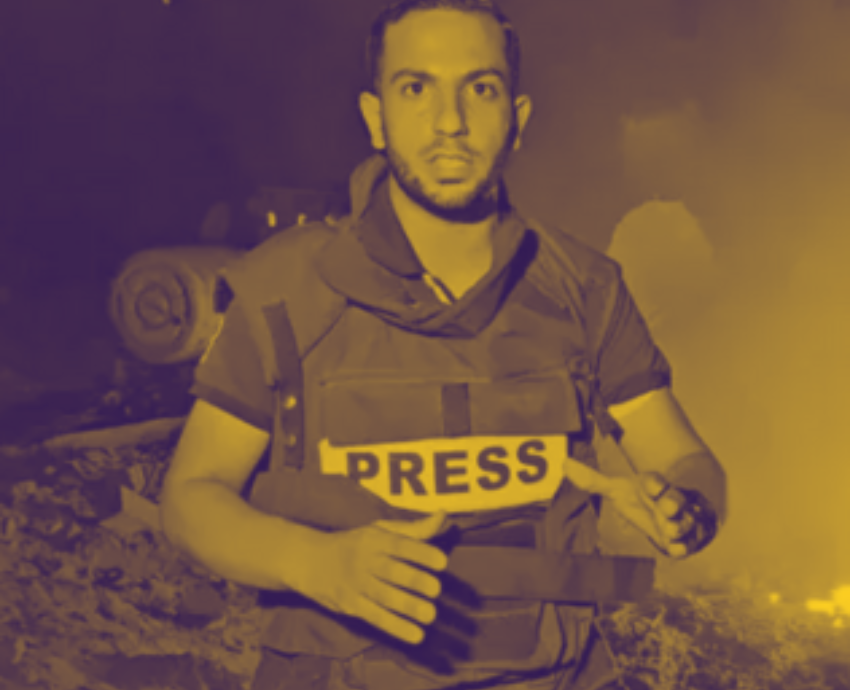
“Assassination,” wrote George Bernard Shaw in The Shewing-Up of Blanco Posnet, “is the extreme form of censorship”. Such extremism visited Al Jazeera journalist Anas al-Sharif and his colleagues in Gaza City late on August 10. An Israeli airstrike killed Sharif as he was resting in a tent located outside the main gate of Gaza City’s al-Shifa Hospital, as well as Al Jazeera correspondent Mohammed Qreiqeh, camera operators Ibrahim Zaher, Mohammed Noufal and Moamen Aliwa, and freelance reporter Mohammed al-Khaldi.
Palestinian journalist Wadi Abu al-Saud recalls the drone attack taking place at 11.22pm. Having entered the tent opposite, he had raised his phone to make a call when an explosion occurred. “A piece of shrapnel hit my phone. I looked back and saw people burning in flames. I tried to extinguish them. Anas and the others had died instantly from the airstrike.” In two subsequent videos, al-Saud vows to “return to my life as a citizen. The truth has died and the coverage has ended.”
Israel Defense Forces international spokesman Lieutenant Colonel Nadav Shoshani claimed that intelligence obtained prior to the strike proved that “Sharif was an active Hamas military wing operative at the time of his elimination”. The reporter must have been frightfully busy then, able to juggle his tasks with Al Jazeera, filing news bulletins while playing the ambitious militant. But distinctions are meaningless for Shoshani, who went on to accuse the slain journalist of receiving “a salary from the Hamas terror group and terrorist supporters, Al-Jazeera, at the same time”.
Evidence is typically sketchy, but Shoshani was untroubled, as the “declassified portion of our intelligence on al-Sharif” was merely small relative to the whole picture. That picture, the IDF contends, revealed Sharif’s credentials as leader of a rocket-launching squad alongside membership of the Nukhba Force company in Hamas’s East Jabalia Battalion. This proved far from convincing to Muhammed Shehada, analyst at the Euro-Med Human Rights Monitor, who made the solid, pertinent observation that al-Sharif’s “entire daily routine was standing in front of a camera from morning to evening”.
Particularly troubling in this killing is that the IDF seemed to be laying the groundwork for justified assassination last month, when army spokesman Avichai Adraee reshared a video on social media making the accusation that al-Sharif was a member of Hamas’s military wing. This proved chilling for the United Nations special rapporteur on freedom of expression, Irene Khan. “Fears for al-Sharif’s safety are well-founded as there is growing evidence that journalists in Gaza have been targeted and killed by the Israeli army on the basis of unsubstantiated claims that they are Hamas terrorists.”
Following Adrae’s remarks, the Committee to Protect Journalists (CPJ) issued a demand last month that the international community protect al-Sharif. “This is not the first time Al-Sharif has been targeted by the Israeli military, but the danger to his life is now acute,” said CPJ Regional Director Sara Qudah. “Israel has killed at least six Al Jazeera journalists in Gaza during the war. These latest unfounded accusations represent an effort to manufacture consent to kill Al-Sharif.”
The other journalists killed in the strike are not deemed worthy of mention by the IDF, affirming the tendency in Israeli military doctrine to kill those around the designated target as a perfectly tolerable practice. Again, Israel discards the rulebook of international humanitarian war in favour of a normalised murderousness.
The rulebook has also been abandoned regarding journalists working in Gaza, conforming to a pattern of indifference to distinctions between militants or civilians in Israel’s sanguinary targeting. By December 2023, the CPJ was already declaring that the war in the Strip had been the deadliest ever recorded by the organisation for press members. (The number currently stands at more than 190; the global total for 2020–23 was 165.) “Israel is murdering the messengers,” concludes Qudah. “Israel wiped out an entire news crew. It has made no claims that any of the other journalists were terrorists. That’s murder. Plain and simple.”
In a statement, Al Jazeera Media Network said the killings are “another blatant and premeditated attack on press freedom”. It said that the order to kill al-Sharif, “one of Gaza’s bravest journalists, and his colleagues, is a desperate attempt to silence the voices exposing the impending seizure and occupation of Gaza”.
Israeli forces’ murder of al-Sharif and his colleagues constituted the effective wiping out of Al Jazeera’s team, one of the few able to offer consistent, unsmothered coverage about the IDF’s remorseless campaign in Gaza. Since the October 7, 2023, attacks by Hamas, Israel has prohibited foreign reporters from entering Gaza except under strict supervision by the Israeli military. Those accompanied by the IDF have been at the mercy of Israeli selectiveness as to where to go and barred from speaking to Palestinians.
In a note to be published in the event of his death, al-Sharif stated that he “lived the pain in all its details”, tasting “grief and loss repeatedly”. This did not deter him from conveying “the truth as it is, without distortion or misrepresentation, hoping that God would witness those who remained silent, those who accepted our killing, and those who suffocated our very breaths”. He also reflected on what images of sheer barbarity had failed to do, with “the mangled bodies of our children and women” failing to move hearts or stop massacres. In dying along with his colleagues, al-Sharif was butchered in a climate of hypernormalised violence, thinly veiled by the barbaric justifications of Israeli national security.
[Binoy Kampmark lectures at RMIT University.]